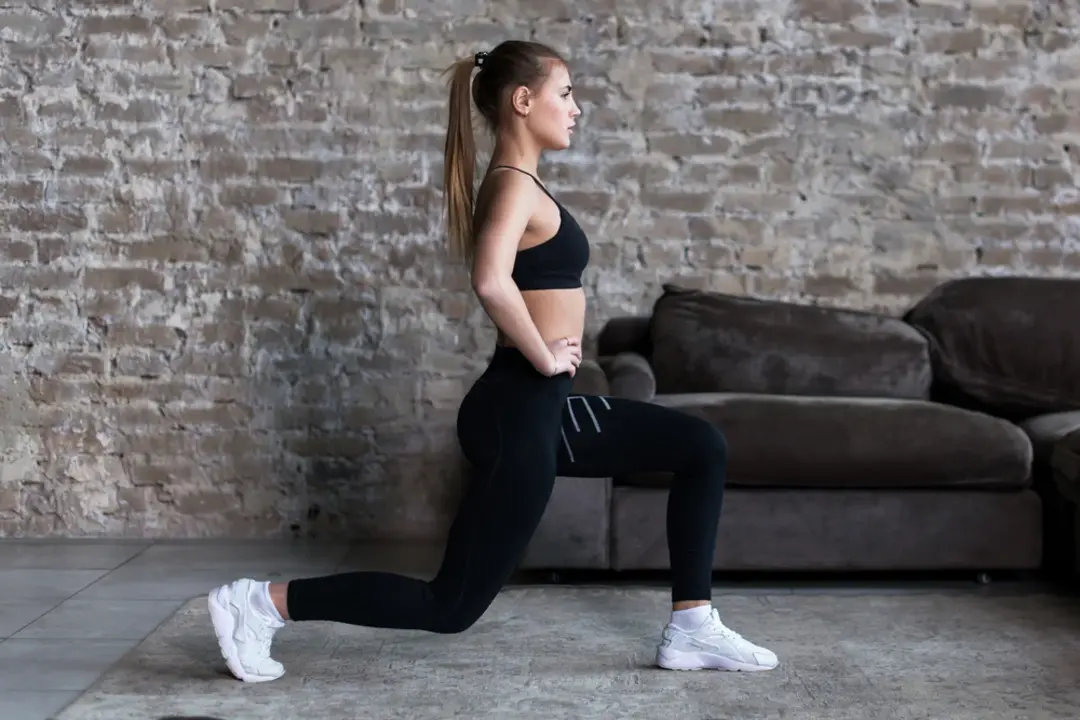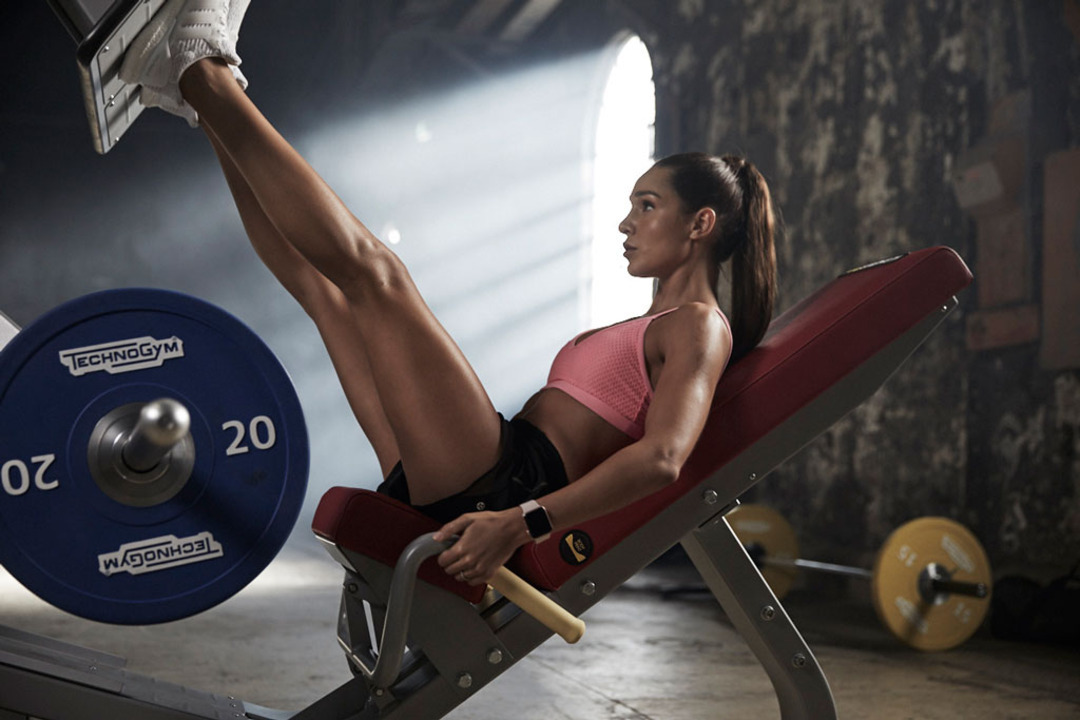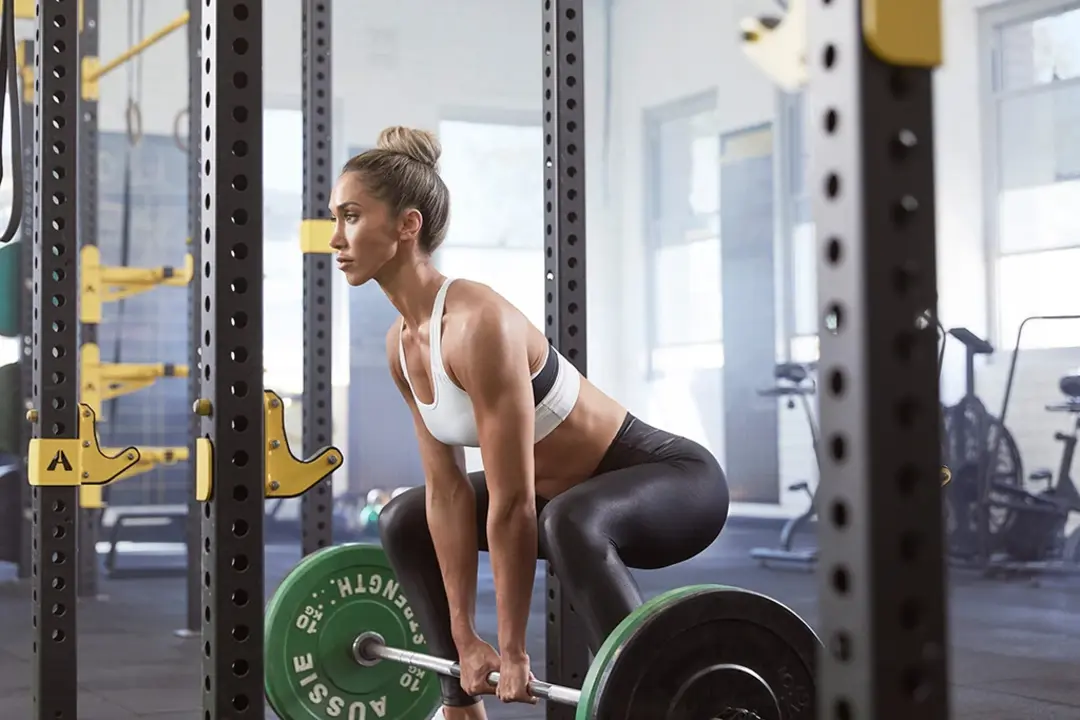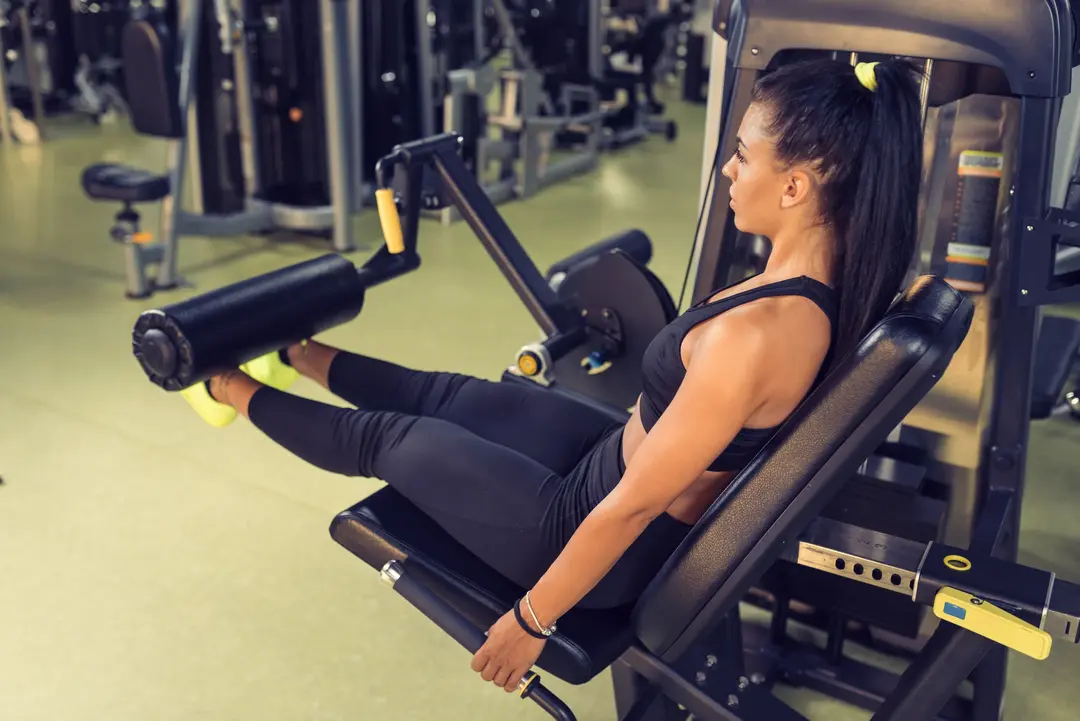21 Best Leg Day Workouts For Women

Sculpt stronger, toned legs with these 21 expert-approved leg day workout women routines, perfect for every fitness level and goal.
Ever opened a workout app for women, tapped leg day, and then wondered if those squats and lunges would actually build stronger quads and glutes? Many women attend lower-body sessions and still experience slow progress, sore knees, or workouts that feel disjointed.
This guide will help you confidently find and follow a comprehensive, practical, and well-structured leg workout plan tailored for women, with clear exercises, rep ranges, mobility work, and recovery tips.
To make that easy, GetFit AI is an AI fitness app that builds personalized leg routines around your goals, experience, and schedule, with video demos, progression plans,s and simple tracking so you can train smarter and see real gains in strength, muscle tone, and endurance.
Summary
- The curated leg toolkit pairs heavy compounds with single-leg work and fatigue resistance across 21 workouts, providing a structured alternative to random move lists.
- Progressing in focused 4 to 8-week blocks that emphasize one driver at a time is more effective than constant novelty, using load increases or time-under-tension to deliver steady overload.
- Participants in the program reported a 20% increase in endurance, showing that the included circuits and loaded carries produce measurable conditioning alongside neural and muscular gains.
- Train legs 2 to 3 times per week instead of compressing volume into one long session, because frequent, appropriately dosed stimulus preserves technique and leverages lower-body responsiveness.
- Warm-ups and cooldowns should be deliberate, lasting about 5 to 10 minutes and using 3 to 5 ramp sets to boost temperature, rehearse patterns, and test concentric speed before heavy work.
- Population-specific tweaks matter: postpartum returns work best with 20 to 30-minute sessions and pelvic-floor cues, while women over 40 should prioritize slightly longer recovery and mobility to sustain progressive overload.
- This is where GetFit AI's AI fitness app fits in, by adjusting load, rep ranges, and recovery based on your performance and symptoms to keep session intent intact as stress accumulates.
21 Best Leg Day Workouts For Women

These 21 workouts are a comprehensive, athlete-authored toolkit for building lower-body strength, power, and resilience, not a haphazard list of exercises. They pair heavy compound lifts with single-leg work and targeted glute isolation, allowing you to prioritize strength and performance while protecting your joints and managing recovery.
What makes this selection different from a generic leg routine?
1. Back Squat
The back squat effectively strengthens the posterior chain, particularly targeting the glutes and hamstrings. This fundamental movement also engages your core and promotes overall lower-body power.
How to perform
- Position a barbell across your upper traps, standing with feet shoulder-width apart.
- Keep your chest open, gaze forward, and toes pointed slightly outward.
- Bend at the hips, lowering your body by flexing your knees while pushing your hips back.
- Ensure knees track outward and avoid collapsing inward.
- Descend until your thighs are roughly parallel to the floor, then press through your heels to stand back up.
2. Front Squat
The front squat places a greater emphasis on the quadriceps than the back squat. It also requires a strong, upright posture, which improves core engagement and spinal alignment.
How to perform
- Rest a barbell across the front of your shoulders with an underhand grip, supporting it with your hands.
- Lift elbows high to secure the bar and maintain a forward gaze.
- Lower into a squat by pushing your hips back and bending your knees, making sure your chest stays tall.
- Keep your knees aligned with your toes and lower until your thighs are parallel to the floor, or as mobility allows.
- Drive upward through the heels to return to a standing position.
3. Romanian Deadlift
This hip-hinge exercise builds strength and flexibility in the glutes, hamstrings, and calves, enhancing posterior chain mobility and power.
How to perform
- Hold a barbell or dumbbells in front of your body with a straight back.
- Slightly bend your knees and bend forward from the hips, allowing the weights to travel close to your legs.
- Lower until you feel a hamstring stretch, keeping your gaze forward and maintaining a neutral neck and back position.
- Engage glutes and hips to pull back to the standing position.
4. Good Mornings
Good mornings are an effective hamstring and lower back exercise that incorporates hip hinging for strength and mobility.
How to perform
- Place a barbell across your traps and stand with your feet shoulder-width apart.
- With knees softly bent, bend at the hips, keeping your torso upright and chest proud.
- Slowly lower your torso forward, pushing your hips back until you feel a stretch in the hamstrings.
- Engage glutes and hamstrings to return to your starting position.
5. Walking Lunges
Walking lunges challenge your balance and strengthen multiple leg muscles, including the quadriceps, hamstrings, and glutes, with the option to add dumbbells for added intensity.
How to perform
- Stand with feet together, optionally holding dumbbells at your sides.
- Take a significant step forward with one leg, lowering the hips until the front thigh is parallel to the floor.
- Keep chest lifted and back straight throughout.
- Push through the heel of the forward leg to stand and bring the other leg forward to repeat the movement.
6. Reverse Lunge
The reverse lunge is a beginner-friendly variation that enhances balance and strengthens the quads and glutes while encouraging proper alignment throughout the movement.
How to perform
- Stand with feet shoulder-width apart, arms relaxed at your sides.
- Step one foot straight back, lowering your body until the front thigh is parallel to the floor.
- Keep your torso upright and core engaged.
- Press through the heel of your front foot to return to the starting position.
- Repeat on the other leg.
7. Lateral Lunge
Unlike traditional lunges, lateral lunges work the side muscles of your legs, improving lateral stability, hip strength, and flexibility.
How to perform
- Stand with feet wider than hip-width.
- Shift your weight to one leg by bending that knee and pushing your hips back, keeping your torso upright.
- Keep the opposite leg straight as you lower your body toward the bent leg.
- Once your knee reaches approximately 90 degrees, push off to return to the starting stance.
- Alternate sides for the desired repetitions.
8. Step Up
Step-ups strengthen the quadriceps and glutes and improve balance by mimicking natural climbing motions. Adding weights boosts the intensity.
How to perform
- Position yourself in front of a sturdy bench or platform roughly one foot high.
- Optionally hold dumbbells at your sides for added resistance.
- Step up with one foot, pressing through the heel to lift your body completely onto the platform.
- Bring the other foot up, then step back down, leading with the same foot you started with.
- Alternate legs or complete all reps per side before switching.
9. Glute Bridge
A simple yet effective exercise that focuses on the glute muscles, the glute bridge promotes hip mobility and strengthens the posterior chain with no equipment required.
How to perform
- Lie on your back with your knees bent and feet flat on the floor, about hip-width apart.
- Engage your core and glutes as you push your hips toward the ceiling.
- Create a straight line from your shoulders to your knees at the top.
- Pause briefly, then slowly lower your hips back down to the floor.
10. Hip Thrust
The hip thrust isolates the glutes superbly, allowing for heavy loading and focused muscle activation to build size and strength in your hips and hamstrings.
How to perform
- Sit on a bench with your upper back supported and feet flat on the ground, shoulder-width apart.
- Rest a barbell, dumbbell, or weight plate on your hips, holding it securely with your hands.
- Drop your hips downward while keeping your feet planted until your torso forms about a 45-degree angle with the floor.
- Push through your heels and lift the hips until your thighs are parallel to the floor.
- Squeeze your glutes at the top before lowering back down.
11. Leg Press
The leg press machine isolates and strengthens the quadriceps, hamstrings, and glutes, providing a controlled environment for building lower-body strength.
How to perform
- Sit on the leg press machine with your back and head against the pad.
- Place your feet hip-width apart on the platform, with your knees bent at approximately 90 degrees.
- Engage your core and push the platform away by extending your legs without locking your knees.
- Slowly bend your knees to lower the platform back to its original position.
12. Leg Curl
Leg curls target the hamstrings and calves, helping to improve muscle balance and knee stability.
How to perform
- Lie face down on the leg curl machine with the padded lever resting just above your heels.
- Grip the handles for stability.
- Pull your heels towards your glutes by bending your knees.
- Pause at the top of the movement, then lower back down in a controlled manner.
13. Bulgarian Split Squat
This single-leg exercise improves balance, targets the quadriceps and gluteal muscles, and significantly enhances unilateral strength.
How to perform
- Stand about two feet in front of a bench, facing away from it.
- Place the top of your rear foot on the bench behind you.
- Lean slightly forward and lower your front leg until the thigh is parallel to the floor.
- Push through your front heel to return to a standing position.
14. Single-Leg Deadlift
Single-leg deadlifts develop hamstring strength and balance, while also increasing core stability and coordination.
How to perform
- Hold dumbbells in both hands with your back straight.
- Shift your weight to one leg and hinge forward at the hips, keeping a slight bend in the knee.
- Extend your other leg back to maintain balance, creating a straight line from your head to your toes.
- Return to standing by engaging your glutes and hamstrings.
- Switch legs after completing reps.
15. Dumbbell Goblet Squat
The dumbbell goblet squat is an excellent exercise for strengthening your quadriceps, gluteals, and core. Holding a dumbbell close to your chest creates resistance, helping to sculpt your lower body while also improving posture and balance.
How to perform
- Hold a dumbbell vertically at chest level with both hands, elbows resting near your sides.
- Stand with feet slightly wider than hip-width, toes angled out gently.
- Push your hips back and bend your knees to lower into a squat, keeping your back straight and core engaged.
- Let your elbows drop gently between your legs as you squat down.
- Pause briefly when your hips are just below your knees, then drive through your heels to stand back up.
16. Dumbbell Deadlift
This movement targets the hamstrings, glutes, and lower back while promoting good hip hinge mechanics, which are essential for functional strength. Dumbbells make this accessible with less risk for beginners, allowing them to progress to heavier barbells.
How to perform
- Stand with feet hip-width apart, holding a dumbbell in each hand with palms facing inward.
- Slightly bend your knees and hinge forward from the hips, lowering the dumbbells down the front of your legs while keeping a flat back.
- Stop when you feel a deep stretch in the hamstrings.
- Engage your glutes and core to pull your torso back to an upright position.
17. Walking Lunges
Walking lunges are an excellent exercise for developing dynamic leg strength, balance, and coordination. You can personalize the intensity by adding weights or performing the exercises with just your bodyweight.
How to perform
- Begin standing tall, feet shoulder-width apart. Support hands on hips if no weights.
- Step forward with the right leg, dropping hips so the right thigh is parallel to the floor and the back knee lowers toward the ground.
- Push through the right heel to step the left leg forward into the next lunge.
- Keep moving forward, alternating legs for the desired number of reps.
18. Calf Raises
Calf raises develop the muscles in your lower leg that support ankle stability and foot strength. Adding dumbbells or elevating on a step amplifies the challenge.
How to perform
- Stand upright with feet shoulder-width apart and hands at your sides or holding dumbbells.
- Gently press onto the balls of your feet, lifting heels as high as possible.
- Pause while boosted, then slowly lower heels back down.
- For a greater range, perform on the edge of a step, letting heels drop below toe level.
19. Glute Bridges
Glute bridges isolate the glute muscles, enhancing hip mobility and strengthening the posterior chain. Adding weights to the hips increases the difficulty and activates more muscles.
How to perform
- Lie on your back with knees bent and feet flat, hip-width apart. Arms rest alongside your body.
- Engage your glutes and core to lift your hips, forming a straight line from your shoulders to your knees.
- Squeeze glutes intensely at the top, hold for a second or two.
- Lower hips back to the floor in a controlled motion.
20. Banded Kneeling Hip Abduction
This exercise targets the outer hips and gluteus medius, helping to improve hip stability and prevent injuries. Using a resistance band adds extra tension, but you can start without it to master the form.
How to perform
- Position yourself on your hands and knees, with your shoulders aligned over your wrists and your hips over your knees.
- Place a short resistance band around your thighs, just above the knees.
- Keep your knee bent at 90 degrees and slowly lift one leg out to the side, rotating through the hip without moving your upper body.
- Lower the leg slowly back to the starting position.
- Complete the desired reps before switching to the other leg.
21. Banded Kneeling Kickback
Kneeling kickbacks with a resistance band strengthen the glutes and hamstrings, enhancing both muscle tone and hip mobility. The band increases resistance for a more effective workout.
How to perform
- Begin on all fours with hands under shoulders and knees under hips.
- Attach a long resistance band around one foot and hold the other end securely with your hands on the floor.
- Extend the banded leg straight back and upward, focusing on squeezing the glutes at the top of the movement.
- Slowly return the bent knee towards your chest.
- Perform the set for one leg, then switch to the other side.
What outcomes can you expect, and how are they measured?
These workouts produce both neural and muscular gains because they blend high-load and high-effort work. A program evaluation from 21 Best Leg Day Workouts For Women reported that participants experienced a 20% increase in endurance after the workout program, showing the conditioning value of the circuits and loaded carries included in the plan. Track progress with objective markers, such as weight on key lifts, unilateral symmetry tests, and brief performance checks like timed step-ups or loaded carries.
How do you adapt these moves for postpartum and older lifters?
When we coached groups of new mothers through phased returns, the most effective change was constraint-based: reducing impact, shortening sessions to 20 to 30 minutes, and adding pelvic-floor-friendly cues for the hinge and brace. For women over 40, prioritize progressive overload by incorporating slightly more extended recovery periods between heavy sets, and emphasize the importance of protein, adequate sleep, and regular joint mobility exercises. In practice, that means swapping high-impact step variations for controlled step-ups, and using single-leg progressions to correct imbalances without adding unnecessary volume.
Most people follow cookie-cutter leg plans because they are familiar and straightforward, and that works at first. However, as you push intensity and accumulate fatigue, that approach fractures: progress stalls, minor aches become persistent, and training feels like a grind rather than a means to an end. Platforms like GetFit AI, which deliver athlete-voiced guidance and adaptive programming, close that gap by adjusting load, rep ranges, and recovery based on your performance and symptoms, ensuring consistent progress as demands rise.
Where do these exercises fit into a typical training week?
Think priority first: place heavy compounds early in the session when the nervous system is fresh, then move into unilateral work and glute isolation, and finish with banded or mobility work that promotes recovery. For hybrid athletes who run or play sports, use the accessory moves as connective tissue between speed or skill sessions, rather than as extra fatigue producers. That sequencing protects the technique on lifts and keeps the adaptations focused on strength and functional power.
What common technical failures undermine results?
The usual culprits are poor hip hinge mechanics, compensatory lumbar extension, and allowing knees to collapse inward during squats and lunges. Fixes are concrete: coach a posterior weight balance to restore heel drive, cue knees to track with toes using a band loop to build motor patterning, and program light, tempo-controlled Romanian deadlifts to re-establish hamstring length-tension before adding heavy loads. Think of the hip hinge like closing a toolbox lid, controlled and from the hinge point, not the spine.
A lot of progress comes down to one overlooked detail: consistent, appropriately dosed recovery that lets the nervous system consolidate strength gains without eroding technique.
You will not believe how much difference frequency and recovery timing make until you test it next.
How Often Do Women Need to Train Their Legs?

Train your legs multiple times across the week rather than trying to cram progress into a single session, because frequent, appropriately dosed stimulus wins over sporadic punishment. Spread intensity and variety so fatigue never erases the technical quality that actually builds strength.
How many sessions fit a realistic week?
Women should train their legs 2-3 times per week. This guidance strikes a practical balance between stimulus and recovery for most women, helping to maintain lift quality while steadily accumulating volume. Practically, this can be three short, focused sessions, two fuller lower-body days with one lighter microdose, or a couple of full-body workouts that include concentrated leg blocks. Choose the shape that fits your week, and then make it repeatable.
Why do legs tolerate more frequent work?
The research title is: Muscle strength gains per week are higher in the lower body than the upper body in resistance training among healthy young women. Points to a real physiological pattern: larger muscle groups in the legs respond robustly to repeated loading when recovery permits. That means you can use slightly higher weekly density for lower-body work, but only if you manage nervous system fatigue and keep technical execution high rather than chasing raw volume.
How do you tell if frequency is helping or hurting?
Watch performance, not soreness. If your jump height, rep speed, or ability to hold tempo drops across sessions, you are stacking fatigue; if those measures improve or stay steady while perceived exertion falls, you are progressing. Other red flags include persistent sleep disruption, rising resting heart rate, and stalled concentric speed on heavy sets. When those show up, pull back intensity, keep session length under 40 minutes for a week, and focus on technique and speed work instead of heavier loading.
What scheduling patterns actually work for busy lives?
This challenge appears across weekend lifters and shift workers, where leg training is either compressed into one exhausting day or skipped entirely until urgency forces a binge. The better pattern is micro-loading: three shorter sessions with specific aims, for example, one strength-focused session, one speed or power session with lighter loads, and one higher-rep or stability session that reinforces movement quality. That structure makes consistency possible when time is patched between childcare, meetings, or travel.
Most people tend to do the familiar thing first, which creates hidden costs.
Most women default to a single long leg day because it feels efficient and straightforward. That works for a while, but as intensity rises, it fragments recovery, technique deteriorates, and progress stalls. Solutions like athlete-guided AI programs offer session-level adjustments, athlete-voiced cues, and recovery-aware scheduling, maintaining progression without excess fatigue, thereby keeping training both practical and sustainable as demands increase.
How should you progress week to week without overdoing it?
Treat progress like a serial test, not a spectacle. Increase load or complexity every two to four weeks, but measure success by consistent repetition speed, clean technique, and repeatable effort that leaves room for improvement in the next session. If you want a concrete check, track a short performance test such as a single heavy set or a timed vertical jump once every two weeks; if results hold or improve, your frequency is working.
A short analogy to hold it together
Think of leg training like tuning a string instrument: minor, frequent tweaks keep the sound clear; a single, long tuning session leaves the strings slack again tomorrow. Frequent, precise adjustments build a more reliable tone than sporadic overcorrection.
That simple adjustment changes how leg day feels and performs, but it raises one stubborn question about preparing the body before and after: what happens in those minutes actually makes or breaks the plan.
Related Reading
- Workout Apps For Women
- Beginners' Workout For Women
- Average Deadlift Weight Kg Woman
- Leg Day Workout for Women
How to Warm Up and Cool Down Correctly

Warming up and cooling down are not optional padding; they are short interventions that protect your joints, prime the nervous system, and control how quickly you recover. Do both with intention: a purposeful ramp into intensity, and a calm descent afterward that restores circulation and lowers systemic strain.
What should a productive warm-up actually accomplish?
The goal is to raise core and muscle temperature, restore movement patterns, and activate the exact muscles you will ask to work hard, in that order. Plan your ramp so it progresses from general to specific, and allow at least a brief continuous ramp for cardiovascular activation, since the American Heart Association recommends that a proper warm-up should last at least 5 to 10 minutes, which means you give the heart and muscles time to shift from rest to work without shocking the system. This is why a single one-minute jog followed by heavy squats is a bad idea; the nervous system and connective tissues need gradual stimulus to express force reliably.
How should you structure the ramp before a heavy leg session?
Use three progressive tiers, each with a clear purpose and a short time box. Start with low-load, 3 to 6 minutes of continuous movement to boost heart rate and loosen joints. Transition to movement-specific drills that rehearse the pattern you will use under load, lasting 4 to 6 minutes and concluding with brief activation sets that prioritize quality over fatigue, such as 2 sets of 3 to 5 explosive bodyweight repetitions or a few light ramp sets of the main lift. Treat these ramp sets as rehearsal for speed and posture, rather than volume accumulation; if technique slips, back off the load and correct the motor pattern.
What do warm-up sets actually look like when you need performance, not just comfort?
Think of the warm-up like tuning an engine before a race. Use 3 to 5 ramp sets that gradually approach working intensity, reducing reps as the weight increases, and keep rest periods short to keep the nervous system engaged. Monitor readiness with simple, repeatable checks: does explosive intent feel sharp on a 2-rep rehearsal set, and does bar speed look crisp on the concentric? If concentric speed drops or form degrades, that is the signal to add a technical or mobility microset, not to push through with a heavier load.
Why the cooldown should be deliberate, not rushed
You want to lower heart rate, restore blood flow, and nudge your nervous system toward recovery, so follow the work with light, continuous movement and targeted relaxation techniques, since the American Heart Association, cooling down should last about 5 to 10 minutes, which means a slow 5 to 10 minutes of walking, gentle cycling, or mobility combined with controlled breathing is more effective than stopping cold. Add static holds for muscles that feel tight, and use breathing and a slow tempo to shift into parasympathetic recovery. This micro-routine often reduces next-day stiffness and prevents soreness from turning into reduced performance the following session.
This pattern breaks down in predictable ways. Here is what usually goes wrong
Most lifters default to either skipping the ramp due to time pressure or treating the warm-up as a checklist of stretches that do not translate to improved loaded performance. The hidden cost is subtle and cumulative: sloppy ramps erode technique, which raises injury risk and forces longer deloads later. Solutions like platforms, such as an AI fitness app, provide adaptive ramp sequences and athlete-voiced cues that match your current session intensity and recovery state, so warm-ups scale automatically rather than being one-size-fits-all.
What simple cues and tests make warm-ups and cooldowns practical on busy days?
Use two quick readiness checks before heavy work: a fast 2-rep rehearsal at a low load to assess concentric speed, and a single-leg balance or a 10-second single-leg hinge to spot any asymmetry. If either test flags, insert one targeted drill for 3 to 5 minutes and re-test. After the session, follow a three-minute active cooldown, two static holds for problem areas held with relaxed breathing, and a hydration or protein touch point within 30 to 60 minutes to start recovery. These micro-choices preserve training quality without adding a long checklist to your day.
Ready to train like the legends and finally achieve the body you've always wanted? GetFit AI's AI fitness trainer app lets you follow the exact workout routines that helped Arnold Schwarzenegger, Kobe Bryant, Cristiano Ronaldo, Serena Williams, and over 11 other elite athletes become champions. You can also chat with them whenever you need guidance or motivation. Download the #1-rated AI fitness app for free today to get fit for less than the cost of a single month's gym membership. Because greatness isn't born, it's built one workout at a time.
That next question is the one that will turn these minutes into measurable progress, and it is more decisive than you think.
Related Reading
- Workout Plans For Women
- Free Workout Apps For Women
- Workout Routine For Women
- Full Body Workout For Women
How Many Sets and Reps Should You Do in Your Leg Workout?

Pick a rep scheme that matches the adaptation you want that week, then stack sessions so one goal dominates. For short blocks, alternate a strength-focused block with a hypertrophy-focused block and one lighter session for technique or endurance, allowing you to maintain progress without burning out. Treat sets and reps as tools you rotate, not rules you obey every workout.
When should you use low reps and more sets for strength?
For maximal strength work, use lower reps and more sets to prioritize neural force production, controlled bar speed, and heavier absolute loads. The classic template for that purpose is 5 sets of 5 reps, which forces you to lift near capacity while keeping reps clean. Plan longer rests, reduce accessory volume the same day, and expect slower weekly frequency for those heavy lifts so central nervous system fatigue does not erode technique.
How do you program for muscle size without losing strength?
When your aim is muscle growth and more session density, prioritize moderate reps with controlled tempos and multiple sets. A reliable hypertrophy template uses 4 sets of 8-12 reps, which balances time under tension and load progression. Use these sets on compound movements after a heavy rehearsal, then follow with single-leg or glute-focused accessories to channel volume where you need it most, keeping rests to about 60 to 90 seconds to maintain metabolic stress.
How do you combine different ranges inside one microcycle?
If you only have three leg sessions a week, treat them as distinct signals: one low-rep strength emphasis, one moderate-rep hypertrophy session, and one higher-rep technique or conditioning day. This preserves neural freshness on heavy days while accumulating weekly volume for growth, and it reduces the temptation to cram eight exercises into a single session where nothing gets done well. The useful mental model is gears on a bicycle, shift intentionally, and avoid trying to sprint in every gear at once.
Why cutting exercises actually improves progress.
This pattern appears across many training contexts: when athletes compress too many movements into one session, their key lifts become technical afterthoughts and recovery suffers. The familiar approach is adding variety for “more work,” and at first, it feels productive because soreness equals effort. The hidden cost is subtle; it fragments recovery and steals quality from the lifts that drive strength and performance. Solutions like GetFit AI sequence session-level goals, automatically scale sets and reps based on your recent performance, and deliver athlete-voiced cues, so the high-skill work stays sharp as intensity rises.
How should beginners or taller lifters adjust sets and reps safely?
If your body proportions or training history change how a movement feels, downshift volume and prioritize quality; fewer sets of cleaner reps are more effective than more sets of sloppy reps. When technique degrades on the last rep, that is your cue to remove load or cut a set, not to grind through it. For taller lifters who often require extra mobility or different leverages, reduce unilateral volume until single-leg control is consistent, then gradually add sets back to build symmetry without overtaxing joints.
What practical checks indicate that the rep range is functioning correctly?
Use performance signals, not soreness. If concentric speed, rep quality, or a short performance test such as a 3-rep rehearsal at a known load stays steady or improves across sessions, the current set and rep structure is productive. Suppose those measures fall while perceived exertion rises. In that case, you are piling on fatigue, so drop the volume, shorten the rests, or swap a hypertrophy day for a technique-focused session until those markers recover.
Think of rep ranges as different training gears; the bright plan is not to drive in all of them at once, but to use each gear when the road requires it.
That practical choice feels solved, until you realise why legwork matters in ways most people overlook.
The Importance of Leg Workouts for Women

Leg training is the single most significant multiplier for everyday performance and long-term resilience, because it changes how your body produces force, protects connective tissue, and manages energy. Done right, leg work improves movement economy and gives you a measurable buffer against damage and fatigue, not an aesthetic afterthought.
How do stronger legs change your baseline metabolism and recovery?
Stronger leg muscle shifts how your body stores and uses fuel, raising resting metabolic activity and improving insulin responsiveness. Over several months, this is not theoretical: a 2025 study by Everyday Health found that women who engage in regular leg workouts can increase their lower body strength by up to 30% over a few months, which translates into higher daily energy turnover and faster recovery after intense sessions. Practically, that means you can handle more training without the same drag on sleep and appetite, and you recover faster between intervals or sport efforts.
What role do legs play in injury resistance and tendon health?
The failure pattern I observe across runners and field athletes is consistent: a weak posterior chain and poor eccentric control cause the load to be transferred into tendons and bones, ultimately leading to pain that forces a break. When eccentric strength improves, tendon stiffness adapts positively, which reduces microtearing and chronic irritation. That change is mechanical and quickly apparent in function, even when the external shape does not. As tendons firm and muscles coordinate better, running economy tightens, and the recurring niggles that used to interrupt training start to disappear.
Why does leg training matter for power, not just size?
Power is the rate at which you can express force, and leg workouts teach your nervous system to recruit motor units more quickly and in a more effective sequence. That skill transfers directly to short sprints, quick direction changes, loaded carries, and even everyday tasks, such as recovering balance on a stair or lifting a toddler from the floor. A focused block that trains rate of force development and fast eccentrics improves those outcomes in weeks, because the nervous system adapts sooner than muscle mass.
What do people miss about endurance and leg work?
This pattern is observed in weekend warriors and endurance athletes, where the standard error often misleads them into mistaking mileage for strength. Replacing targeted leg strength work with extra cardio can increase the risk of overuse injury and limit top-end speed. A practical fix is a three-times-per-week microcycle of strength and tempo sessions; sensible loading there improved muscle endurance by measurable amounts in controlled settings, as shown when [a study found that women who performed leg exercises three times a week improved their muscle endurance by 25%. That kind of conditioning raises lactate threshold and delays form breakdown, which is where crashes and aches begin.
Most people treat leg training as a checkbox, and that works while you are small-scale. The hidden cost becomes apparent when goals intensify: inconsistent intensity, undetected asymmetries, and overuse injuries that can derail months of progress. Solutions like GetFit AI offer athlete-authored sequencing, on-demand coaching cues, and adaptive load adjustments that maintain session intent as you accumulate stress, allowing you to scale effort without compromising technique for volume.
Think of leg training like shoring up the foundation of a building; once the piers are more substantial, the whole structure carries weight more safely and effectively.
That simple change feels like progress, until you meet the one thing that really makes elite-level coaching matter.
Make Your Favorite Athlete Your Fitness Trainer | Try GetFit AI's AI Trainer App for Free Today

An athlete-quality, adaptive coach makes leg day repeatable and productive, so consider GetFit AI if you want programming that maps elite routines to your body and schedule while giving on-demand athlete guidance when motivation dips. Over 10,000 users have already joined GetFit AI, and users report a 20% increase in workout efficiency.
Related Reading
- Lower Abs Workout for Women
- Ab Workout Women
- Hiit Workout Women
- Arms Workout for Women



.png)











